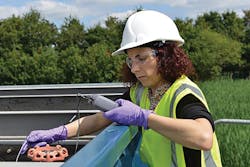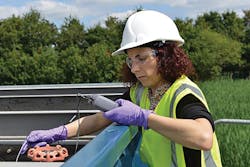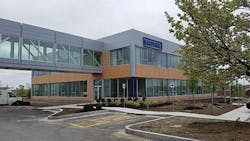Water Briefs
Research: Mixed media improves performance, effluent quality of MBBR systems
Cranfield University’s Water Sciences Institute has completed a three-year research project in partnership with plastic media manufacturer Warden Biomedia, an SME based in Luton, England. This project investigated the influence of Warden’s biomedia physical properties on moving bed biofilm systems, including mixing, oxygen mass transfer, process start-up and effluent quality during steady state operation. The aim was to improve efficiency, cost-effectiveness and sustainability of processes such as submerged aerated filters (SAF), moving bed biofilm reactors (MBBR) and integrated fixed-film activated sludge (IFAS), and trickling filters.
The research concluded that moving bed biofilm systems can be operated with mixed media to improve the overall performance and increase effluent quality. Organic removal can be improved by using spherical media in the first stages of the process, complemented with a higher protected surface area media to improve nitrification. Additionally, strong correlations were achieved between biofilm formation rates, maximum COD utilization rate and ammonia removal rate and the physical properties of the Warden Biomedia products. IWW
Japanese beer maker uses wastewater biogas to power factory
Asahi Group Holdings Ltd. has established a process for purifying the methane gas produced in its brewery wastewater treatment process into high-purity biogas suitable for Solid Oxide Fuel Cell (SOFC) power generation. Using the purified biogas as a fuel, Asahi conducted a power generation experiment on a SOFC power generation test device jointly developed with Kyushu University Next-Generation Fuel Cell Research Center, and successfully generated electricity for more than 2,000 consecutive hours.
Asahi has introduced anaerobic wastewater treatment equipment at its 13 breweries in Japan, allowing it to treat wastewater discharged from the manufacturing process by a fermentation method to produce biogas. This plant-derived, carbon-neutral biogas is then burned in boilers, etc., and reused as heat energy in the facilities. If the biogas were to be used in SOFC power generation to produce electricity more efficiently, however, further reductions in CO2 emissions could be expected. IWW
Gradiant unveils Asia-Pacific headquarters in Singapore
To further its commitment to developing solutions aimed at reducing water scarcity concerns, Gradiant Corporation has announced the establishment of a new research and development (R&D) center in Singapore that will also serve as the company’s Asia-Pacific headquarters.
The creation of this Asia-Pacific headquarters, supported by the Singapore Economic Development Board, will allow Gradiant to expedite the development of innovative solutions for industrial desalination, brine minimization and water reuse. The Singapore facility will initially employ 10 senior water scientists and engineers, many of whom were trained at MIT, with plans to double the size of the team by year-end, capitalizing on Singapore’s deep pool of talent in the water technology sector. Gradiant’s CTO and co-founder Prakash Govindan will lead the Singapore-based team. IWW
KROHNE opens manufacturing, calibration facility
KROHNE Inc. opened its new state of the art flow and level instrument manufacturing and calibration facility in Beverly, Mass., on April 23, 2018. The operations expansion in North America represents the company’s long-term commitment to manufacturing in the United States. The new headquarters facility will produce a variety of new and existing flow and level products, while continuing to serve as the main distribution hub to North American markets for all other products. Administration, sales, service and marketing, and a new training center will also be located in Beverly.
The new production building will be interconnected with a new state of the art, two story office building, tripling the floor space compared to the existing facility in Peabody, Mass. Production and distribution operations will also be transferred to the new space. IWW
CORTEC announces $2.5M expansion of Port Allen facility
CORTEC, a leading manufacturer of high-quality API chokes, valves and manifolds, and Louisiana Economic Development (LED) have announced a $2.5 million expansion of CORTEC’s industrial coatings facility in Port Allen, La.
CORTEC and LED began working on the proposed expansion in March 2018, which will be completed by Q2 2019. The expansion will allow CORTEC to increase its space, equipment and capabilities from its existing operations and expand further into specialized coatings to enhance the performance and lifespan of equipment. CORTEC will create four new jobs and seven indirect jobs with the Port Allen expansion. IWW
Company looks to reuse oilfield water in Wyoming
Marvin Nash, an energy industry consultant, has kick-started a statewide effort to put oilfield wastewater to use in Wyoming. Through his company, Encore Green, and in conjunction with the national Beneficial-Use Water Alliance, Nash hopes to use industry-specific technology to repurpose the long-evaporated remnants of water used in oil extraction.
Last year, Nash and his wife self-funded the effort, investing their life savings into the technology and research necessary for such an endeavor.
Nash’s interest in oilfield water came from his time working as a consultant for EOG Resources, one of the largest oil and gas firms in Wyoming. IWW
CEMEX enters stormwater management agreement in california
CEMEX USA has entered into a plan to enhance stormwater management from three of the company’s ready-mix plants in Southern California to resolve an ongoing dispute regarding the Clean Water Act.
Under the agreement with Los Angeles Waterkeeper, Orange County Coastkeeper and its chapter Inland Empire Waterkeeper, CEMEX will upgrade Best Management Practices (BMPs) for stormwater at plants in Irvine (Orange County), Fontana (San Bernardino County) and Compton (Los Angeles County). CEMEX also agreed to enhance water-testing protocols beyond current testing requirements.
Orange County Coastkeeper and Los Angeles Waterkeeper filed a complaint in early 2017 claiming stormwater from three CEMEX facilities raised pH and metal levels in nearby waterways, violating the Clean Water Act. CEMEX refuted the claims. The recently approved agreement reflects a compromise with the organizations with increased BMPs at each facility.
CEMEX will contribute $55,000 to identify and fund future environmental-mitigation projects through third-party groups Rivers and Lands Conservancy (Inland Empire), Pacific Marine Mammal Center (Orange County) and From Lot to Spot (Los Angeles County).
CEMEX is expected to complete its facility upgrades by October 15, 2018. IWW
EPA settles with two Arizona-based facilities over Clean Water Act violations
The U.S. Environmental Protection Agency (EPA) announced settlements with two Goodyear, Ariz.-based companies to resolve Clean Water Act (CWA) violations. BioFlora, a fertilizer manufacturer, and Inventure Foods, a food manufacturer, will pay $39,000 and $79,957 in civil penalties, respectively. Each company has made improvements to their facilities’ wastewater pretreatment systems to achieve compliance with local and federal pretreatment standards.
During inspections in 2016 and 2017, EPA found that BioFlora and Inventure discharged wastewater violating local and federal standards from their manufacturing facilities into the City of Goodyear wastewater system.
As part of negotiations with EPA, BioFlora installed a wastewater recycling system, allowing it to become a zero-discharge facility. Inventure upgraded its wastewater system and operations procedures through an Administrative Order on Consent.
Municipal wastewater treatment facilities are not designed to treat industrial wastewater; as a result, industrial facilities are required under CWA to pretreat wastewater before it enters municipal drains. IWW




